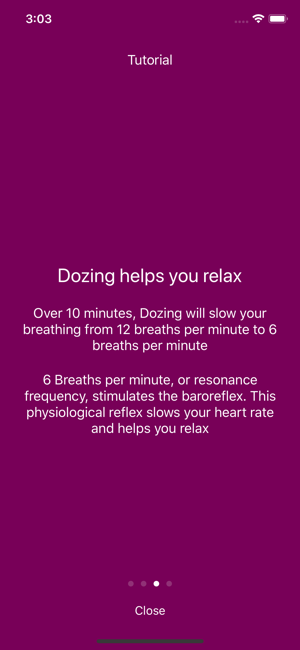價格:免費
檔案大小:8.4 MB
版本需求:系統需求:iOS 11.2 或以後版本。相容裝置:iPhone、iPad、iPod touch。
支援語言:英語

Meditate easily and improve your sleep with Dozing, a simple application that uses your phone's camera flashlight to help you relax. By breathing in rhythm with your phone's camera flashlight, you will be able to relax and sleep better in only 10 minutes!
Research shows that by breathing at a rate of 6 breaths per minute people feel more relaxed and have an improved mood. Dozing uses your phone's flashlight to gradually slow your breathing from a normal rate of 12 breaths per minute, to a relaxed rate of 6 breaths per minute.
Simply lay in bed and face your phone flashlight towards the ceiling. As the room becomes gradually brighter, breathe in, and as the room becomes dimmer again, breath out.
Focusing on the light will keep your breathing steady, while also eliminating outside thoughts and distractions. This mindfulness technique helps you reach a sense of calm, and drift easily into a good nights sleep.
Throughout the meditation, dozing uses a 1-to-1 inhale-to-exhale ratio which has also been shown by researchers to increase a feeling of relaxation.
This application does not use verbal guides, but rather purposefully keeps your phone volume silent so that you can ease into sleep.

Having a regular bed-time improves sleep quality. Dozing has a built-in and customizable reminder feature so that you can regularly go to bed at a time that fits your schedule.
Dozing is the newest meditation technique on the app store! Try it yourself and see if it improves how quickly you fall asleep!
Incorporate Dozing into your daily routine. and you'll be dozing in no time!
RELEVANT RESEARCH STUDIES
Steffen, Patrick R., et al. “The Impact of Resonance Frequency Breathing on Measures of Heart Rate Variability, Blood Pressure, and Mood.” Advances in Pediatrics., U.S. National Library of Medicine, 25 Aug. 2017, www.ncbi.nlm.nih.gov/pmc/articles/PMC5575449/.

Lin, I M, et al. “Breathing at a Rate of 5.5 Breaths per Minute with Equal Inhalation-to-Exhalation Ratio Increases Heart Rate Variability.” Advances in Pediatrics., U.S. National Library of Medicine, Mar. 2014, www.ncbi.nlm.nih.gov/pubmed/24380741.
